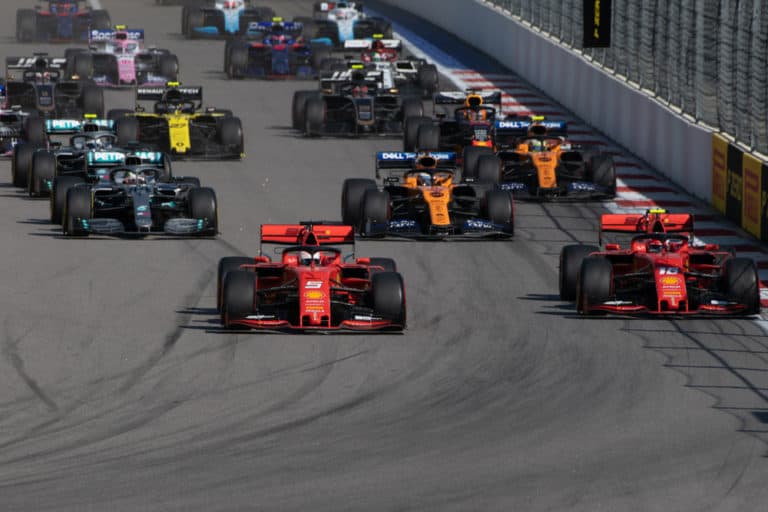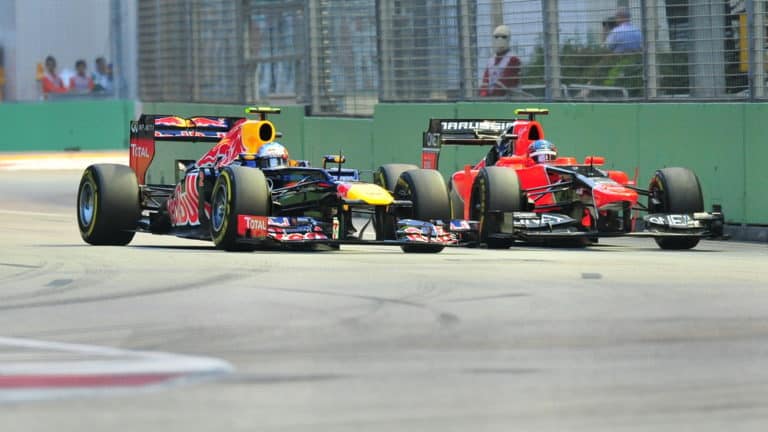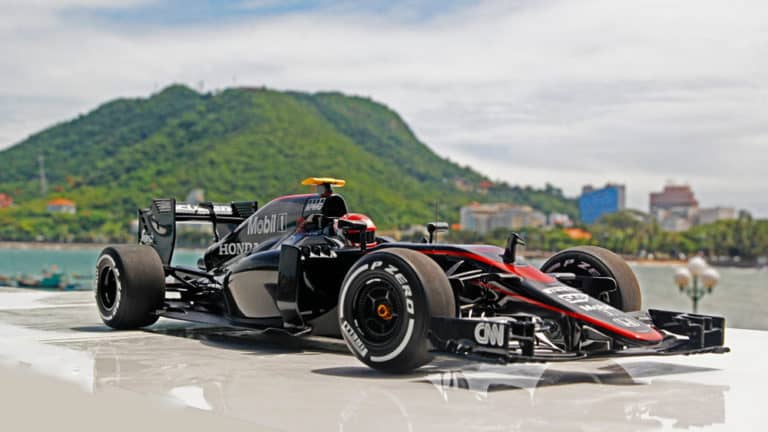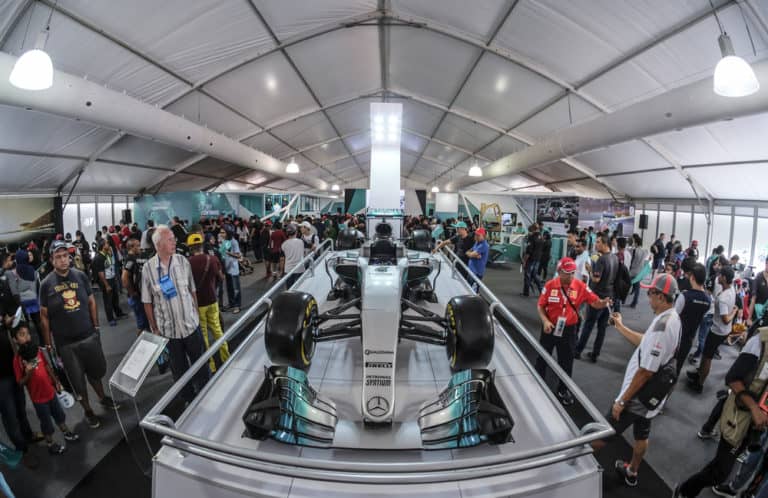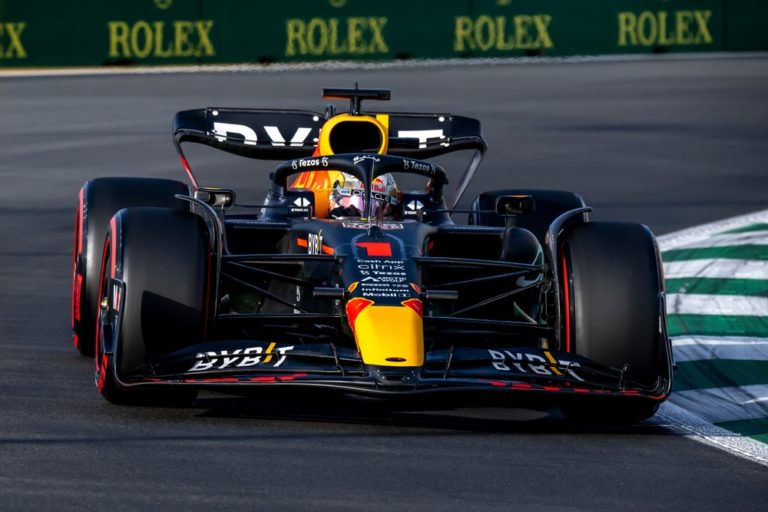Like many racing fans, Netflix’s Drive to Survive has reignited my interest in the off-track aspects of the sport. The behind-the-scenes drama, the interpersonal competition. But the absence of Americans on the show raises some questions. What was the past of American F1 driving like? And who were the leading faces?
The best American Formula One drivers spanned a period from the 1950s to the 1980s. Most of them were born in the USA, and two were naturalized immigrants. Their victories spanned the leading races around the world. Mario Andretti has had the most successful career of the ten.
We’ll sketch the history and then profile the top ten American F1 drivers.
If you’re looking for some F1 merchandise, check out the awesome stuff at the official F1 store here.
F1 In America
Although the Indianapolis 500 is now the bedrock of the IndyCar series, it was once a regular fixture on the Formula One calendar. This was where America’s institutional relationship with Formula One began.
Starting in 1950, the maiden season of F1 in America, the Indy 500 was an official round of the World Championship for the next decade – the only American entry on the circuit.
One complication was that the race ran to different regulations than the other events on the calendar, meaning that participants needed purpose-built cars to participate. The only European driver to mount this challenge was Alberto Ascari, who finished 31st in the 1952 event.
From 1961 a new and permanent home was found at Watkins Glen for the United States Grand Prix.
Currently, two factors are cited as working against the emergence of American Formula One drivers – economy and economics.
Economy relates to the value chain that supports Formula One. All the teams are based in Europe. So too are the minor racing series which lack prestige but serve as feeders for young drivers into Formula One. Most of the technical experts – aerodynamicists, engineers, drivetrain experts, and engine manufacturers, are concentrated in England. This draws young talent overseas.
Economics refers at bottom to popularity. Although this is changing now, stock car racing, drag racing, and the Indy 500 are crowd magnets that have, historically, diluted crowd interest in Formula One. And talented young drivers tend to follow the large crowds and bigger money.
Formula one is highly technical. The arms race between competing teams involves custom building cars to derive an edge through narrowing advantages with increasingly hard-to-understand technology. It is difficult to interest crowds in this.
Television has sought to popularise the sport by appealing to its charismatic champions. It remains to be seen whether the Netflix focus on off-track interpersonal drama will translate into sustained interest in a highly technical sport, where the personalities are veiled in execution.
The Best American F1 Drivers
With the scene set, let’s meet the masters who took American F1 racing to the top.
1. Mario Andretti
| Born | February 28, 1940 |
| State | Montona, Italy (present Croatia) |
| Career | 1968-1972, 1974-1982 |
Early Life
Mario and his twin brother were born to Italian parents who fled in 1948 following the post-war annexation of parts of Italy by Yugoslavia. According to their mother, the two-year-olds would play race cars with pot lids on the kitchen floor before they’d seen real cars.
In 1955 the family migrated to the USA, settling in Pennsylvania. Mario’s plans to become a welder were derailed when he forged an I.D. to become age-eligible for an amateur race. By 1961 Mario has twenty-one wins from forty-six races.
Career
Mario Andretti was crowned Formula One World Champion in 1978. He raced for Lotus, March, Ferrari, Parnelli, Alfa Romeo, and Williams. In his fourteen-year career, he amassed one hundred and eighty points with a stunning twelve wins out of “only” nineteen podium finishes:
Since 2012 Andretti has been a Formula One ambassador, promoting awareness of the sport in the country.
2. Phil Hill
| Born | April 20, 1927 |
| State | Florida |
| Career | 1958-1964, 1966 |
Early Life
Born in Miami, Hill’s family moved to California, where at the age of nine, he took his first drive in a brand new Oldsmobile. This sparked what Hill would describe as a lifelong “obsession” with motor cars and racing. In 1946 the teenage Hill became one of the first dozen members of the California Sportscar Club.
Career
Phil Hill was the only American-born Formula One World Champion, racing for Ferrari in 1961. He was the first American to win the Le Mans 24hour endurance race, a feat he would repeat twice. His endurance hat trick would also apply to the Sebring 12hour race.
Hill raced for Maserati, Ferrari, Cooper, Porsche, Turismo, Lotus, McClaren, and Eagle. His forty-nine Formula One World Championship starts included sixteen podium finishes, among them three wins:
After retirement, he partnered with Ken Vaughn to start the award-winning Hill and Vaughn classic car restoration business. After visiting a historic automobile race in Monterey Hill took ill and died in a local hospital from Parkinson’s Disease complications.
3. Dan Gurney
| Born | August 13, 1931 |
| State | New York |
| Career | 1959-1968, 1970 |
Early Life
Born in Port Jefferson, Gurney moved to California following his father’s retirement from New York’s Metropolitan Opera Company. After graduating from Manhasset High School, Dan got involved in California’s hot rod scene. At the age of nineteen, he built and raced his first car, reaching speeds of one hundred thirty-eight miles per hour.
Gurney became a drag and sports car racer punctuated with a two-year stint in the American army in the Korean war.
Career
Gurney had a wide involvement with racing, spanning driving, construction, and team ownership. In a career spanning eleven years and eighty-six starts, Gurney sported four wins, with a cumulative one hundred and thirty-three-point score. His nineteen Formula One World Championship podium finishes are distributed as follows:
In 1962 Gurney convinced Goodyear to back him as a constructor. They formed All American Racers in a bid to challenge Firestone’s dominance of the American racing scene. Gurney managed the team full-time from his retirement in 1970 until his son Justin took over in 2011.
Gurney died of pneumonia at the age of eighty-six.
4. Peter Revson
| Born | February 27, 1934 |
| State | New York |
| Career | 1964, 1971-1974 |
Early Life
Revson was born to Martin and Julie Revson. His father and uncle were the founders of the Revlon cosmetics company. Peter obtained expensive education, attending prep schools and top universities, including Cornell and the University of Hawaii. He did not finish his college career.
The young Revson had a playboy reputation and was – at the time of his death – engaged to Marjorie Wallace, the 1973 Miss World.
Career
Revson raced for Lotus, Tyrell McClaren, and Shadow. He had thirty Formula One World Championship starts with eight podium finishes, including two wins:
On March 22, 1974, Revson was at the Kyalami track in Midrand, practicing for the South African Grand Prix. Driving a Shadow DN3, he experienced front suspension failure, crashing into a barrier.
The car wrapped around the barrier and burst in flames. The rescue was pried out the cockpit but had already died, following his brother, who expired in a racing crash in Denmark in 1967.
He was replaced by Tim Pryce, who died three years later at the same Grand Prix. In 1996 Revson was inducted into the Motorsports Hall of Fame of America.
5. Eddie Cheever
| Born | January 10, 1958 |
| State | Arizona |
| Career | 1978-1989 |
Early Life
Born in Phoenix, Cheever spent his childhood in Rome, Italy, attending St George’s British International School. In Europe, he was introduced to motorsports at the age of eight when his father took him to a race in Monza. He took to racing go-karts, winning the Italian and European Karting Championships at the age of fifteen.
Career
Cheever amassed seventy points over one hundred and thirty-two starts. He made nine podium finishes, missing a win. Over his ten-year career, he joined the teams of Theodore, Hesketh, Oselia, Tyrrel, Ligier, Renault, Alfa Romeo, Haas Lola, and Arrows.
While Cheever made his Formula One debut in the 1978 South African Grand Prix, he had to retire early from the event. 1983 was his best year. Scoring four podium finishes, he finished seventh in the championship and won one front row start for Renault. His Formula One World Championship podium record is listed here:
Cheever raced different formulae for over thirty years. His number of Formula One starts is the greatest for any American driver. His son Eddie Cheever III, nephew Richard Antinucci and brother Ross Cheever also became racing drivers.
6. Richie Ginther
| Born | August 5, 1930 |
| State | California |
| Career | 1960-67 |
Early Life
Champion Phil Hill was a friend of Ginther’s elder brother. Richie worked with his dad at the Douglas aircraft factory before making his racing debut in 1951. But on his twenty-first birthday, Ginther was drafted into the U.S. Army and sent to Korea for a two-year stint.
Career
Vukovich raced for Ferrari, Scarab, BRM, Honda, Cooper, and Eagle. Over fifty-two starts, he scored fourteen Formula One World Championship podium finishes. They were:
Ginther developed a reputation as a strong team player but without the edge to win regularly. He was replaced at BRM by Jackie Stewart and took up with the startup F1 team at Honda. This move was rewarded with an emphatic win at Mexico in 1965, trouncing fellow American Dan Gurney.
In 1989, deep into retirement at the age of fifty-nine, Ginther accepted an invitation to Donington Park, marking the fortieth anniversary of the 1.5l F1 BRM, a vehicle he was familiar with. He attempted a few lapses, but a prematurely frail body could not handle the strain. Days later, holidaying in France, he succumbed to a fatal heart attack.
7. Bill Vukovich
| Born | December 13, 1918 |
| State | California |
| Career | 1950-1955 |
Early Life
Bill was one of eight children born to Yugoslav immigrants. The father was a carpenter and farm owner who committed suicide on Bill’s fourteenth birthday. During the great depression, the family’s only source of income was its Model T Ford, which Bill would monetize by chasing rabbits through a field.
Realizing that there could be money in automobiles, he started competing for cash in the early 1930s. In his first competition, he finished second, driving a modified Chevrolet.
Career
Vukovich raced for Kurtis Kraft, Trevis, Rounds Rocket, and Maserati. His career had five entries, and two podium finishes – both wins, being the 1953 and 1954 Indianapolis 500. Roger Ward, who twice won the Indy 500, described Vukovich as “probably the greatest actual driver we have ever known in terms of his skill and determination.”
In lap fifty-seven of the 1955 Indianapolis 500, Vukovich held a seventeen-second lead. Exiting the second turn and trailing three slower cars, one of the three cars – driven by Richard Ward – flipped as its axel broke.
The result was a chain collision that sent Vukovich’s car cartwheeling through the air, landing upside down on a set of parked cars where it burst into flames. The driver dies instantly. He was thirty-six years old.
8. Masten Gregory
| Born | February 29, 1932 |
| State | Missouri |
| Career | 1957-1962 |
Early Life
“Kansas Flash” was born in Kansas City to an insurance dynasty. He would use his inheritance to buy a Mercury-powered Allard, driving it in his first race, the fifty-mile SCCA in Caddo Mills, Texas. His elder brother Riddell was a race car driver too.
Gregory attended the Pembroke County Day School, leaving before completing his senior year.
Career
Gregory was near-sighted, requiring thick eyeglass to navigate. Apart from being the world’s worst-sighted driver, he was the first American to regularly tour the European circuit.
Gregory had thirty-eight Formula One starts, racing for Cooper, BRM, Maserati, Behra-Porsche, Lola, and Lotus. He amassed twenty-one career points, and three podium finishes, finishing 3rd at Monaco 1957 and the Dutch Grand Prix of 1959. He finished 2nd at the 1959 Portuguese Grand Prix, narrowly ahead of fellow American David Gurney.
Monaco 1957 marked his F1 World Championship debut, making him the first American to get a podium finish in his first race. He also won the Le Mans twenty-four-hour endurance race.
In 1960 Cooper did not renew Gregory’s contract, widely rumored (as believed by Gregory himself) to be at the behest of Jack Brabham. Gregory retired from title racing.
9. Jim Rathmann
| Born | July 16, 1928 |
| State | California |
| Career | 1950-1960 |
Early Life
Royal Richard Rathmann was born in Alhambra, California. He was too young to race at the age of sixteen and so borrowed the I.D. of his elder brother Jim. The name stuck, and the two siblings entered into what would be a permanent name swap. Brother James, two and a half years older, went on to become the Indianapolis 500 pole sitter in 1958.
Career
Rathmann went on to an illustrious motor racing career, winning the Indianapolis 500, which was part of the Formula One World Championship from 1950-1960.
Rathmann completed ten Formula One entries. He had one win, four podium finishes, and twenty-nine career points. He never managed pole position. The podium finishers were all in the Indy 500. In 1952, 1957, and 1959, he finished 2nd.
Many cite the 1960 edition as the best ever Indy 500. It certainly was a closely fought contest between Rathmann and defending champion Roger Ward. Neither ever led by a few feet, the lead changing hands fourteen times. Finally, with three laps remaining, a worn tire forced Ward to slow, allowing Rathmann to break his 2nd place hat trick.
The teams spanned Kurtis Kraft, Epperly, Watson, Wetteroth, and Moore. In all World Championship races, he had an Offenhauser L4 engine.
10. Mark Donohue
| Born | March 18, 1937 |
| State | New Jersey |
| Career | 1971-1975 |
Early Life
Donohue was born in Haddon Township and grew up in Summit. After graduating from Hillside’s Pingry School, he enrolled at Brown University in Rhode Island, graduating with a bachelor’s degree in mechanical engineering. His racing interest took off when as a senior in 1957, he raced his Corvette to victory in the first race he entered.
Career
After winning the SCCA national championship in 1961, he was approached by race driver Walt Hangse of Inskip Motors, who provided the MGB with which Donohue won the 1964 Bridgehampton 500-mile endurance event.
Donohue’s Formula One debut was a podium finish at the 1971 Canadian Grand Prix. He raced a Penske-McClaren, finishing third. After retiring from motorsport, he was enticed back to Formula One by Roger Penske, participating in the 1974-75 season.
The 1974 season was lackluster. He finished 12th at the Canadian Grand Prix and didn’t make the finish at the United States Grand Prix. The next year so a full racing season for Donohue.
1975 was hard for him. Donohue finished 5th at both the British Grand Prix and the Swedish Grand Prix. However, there were chassis problems with the new Penske PC1, causing early withdrawals in the first six races.
Continued trouble from the PC1 saw Donohue ditch that car in mid-1975 for the March 751. During a practice session for the Austrian Grand Prix, tire failure caused him to lose control of the car. A track marshal was fatally struck by debris. Head trauma saw Donohue lapse into a fatal coma, succumbing to a cerebral hemorrhage.
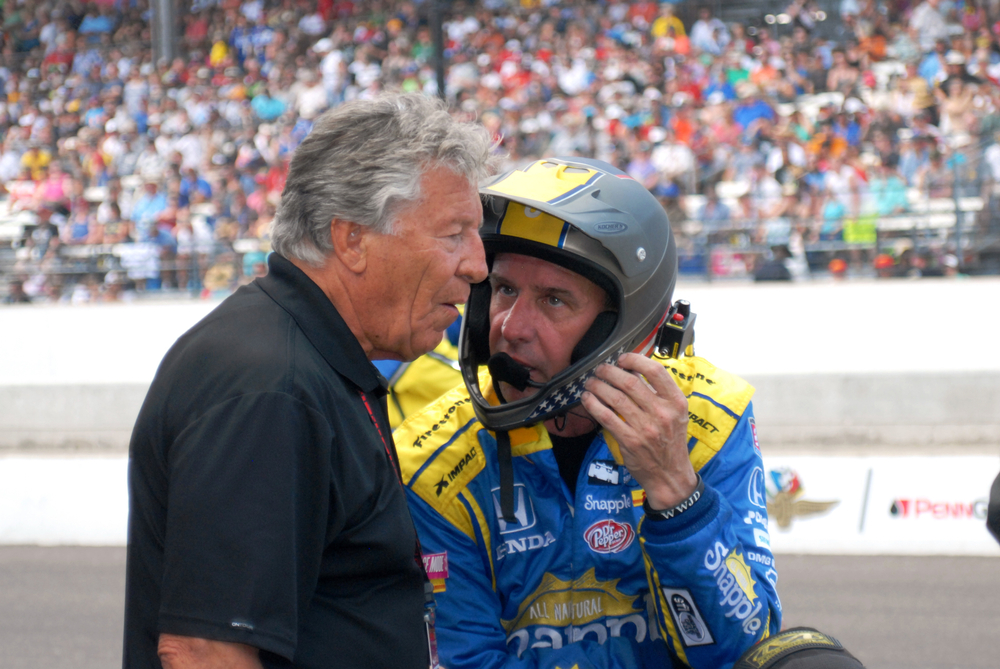
The Future Of F1 American Drivers
Currently, there is a dearth of American drivers in the Formula One series. This is a concern, as the United States is regarded as a major potential growth market for the sport. Both Williams and Haas have American owners, and a US-based investment group owns a minority stake in McLaren.
A second race is being added in Miami, Florida, to join the existing one in Austin, Texas.
Presently the junior feeder series Formula Three has four American drivers. McLaren has recently signed Ugo Ugochukwu, an American go-karter aged thirteen. He will join on a development contract.
Continued interest is being sparked not only with Netflix’s Drive to Survive but through Lewis Hamilton, the charismatic champion who spends a lot of time in the United States.
Formula One, the governing body, is working with racing teams to identify American drivers who have the potential to progress to Grand Prix racing. They have indicated that this is a mid-to-long-term project.
Most recently, Alexander Rossi, who had five starts with the Marussia team in 2015 (he placed 12th in the best showing.) Rossi since left and won the Indianapolis 500 in 2016, still a rookie.
Recently, retired champion and sports ambassador Mario Andretti has been outspoken on the issue, asserting that American drivers need to be in an American team for them to be taken seriously in Formula One.
There is the expectation that the Andretti Autosport organization could take a majority stake in Sauber, a team currently running under the Alfa Romeo brand in Formula One. On the back of that, American Colton Herta might get an imminent F1 turn.
Conclusion
With an infusion of public interest and a steady talent stream, the American Formula One Hall of Fame is set for changes. But the unerasable history of the nation’s great racers will serve as permanent inspiration for the next generations.
References
- https://bleacherreport.com/articles/2320716-ranking-the-top-10-us-drivers-in-f1-history
- https://www.autoweek.com/racing/formula-1/a38470001/american-f1-hopeful-test-williams-abu-dhabi/
- https://www.thefamouspeople.com/american-f1-drivers.php
- https://www.espn.com/f1/story/_/id/31408890/f1-working-teams-find-future-american-drivers
- https://www.wired.com/2014/10/austin-americans-f1/
- https://www.sportscasting.com/williams-racing-american-driver-formula-one/
- https://the-race.com/formula-1/andretti-americans-will-only-get-fair-f1-shot-with-a-us-team/
- https://www.gpfans.com/en/f1-news/71106/which-american-drivers-could-make-f1-jump/
- https://www.youtube.com/watch?v=yH6R69qCTLA
- https://www.washingtonpost.com/sports/2021/10/26/formula-one-us-grand-prix/
- https://www.theguardian.com/media/2021/dec/17/netflixs-drive-to-survive-americans-f1-fans

